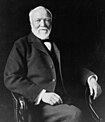Carnegie Mellon University Alma Mater
| "Alma Mater - Carnegie Mellon University" | |
|---|---|
| Song | |
| Written | 1924 |
| Genre | Alma mater |
| Composer(s) | J. Vick O'Brien |
| Lyricist(s) | Charles J. Taylor |
Listen to the song Carnegie Mellon University Alma Mater or Buy it on amazon
The alma mater of Carnegie Mellon University was written by Charles J. Taylor and set to music by J. Vick O'Brien when the university was still known as Carnegie Institute of Technology. The song was copyrighted by the institute in 1924.
Use[edit]
While not as commonly used as at some other universities, the alma mater plays a critical role in the culture and history of Carnegie Mellon University. It is sung at convocation ceremonies of incoming classes, commencement ceremonies of graduating classes, and other official events such as the investiture of new presidents. The university's Kiltie Band plays it at certain home games as well.
Lyrics[edit]
The full song is composed of three verses. However, usually, only one the first verse is usually performed.
First Verse[edit]
The first verse references history of Pittsburgh, Pennsylvania where the university is located. In the late-18th Century, after the United States won its independence, the settlement at the present day city of Pittsburgh was known as the frontier and the Gateway to the West. The verse describes the presence of the wildernesses through which the original westward-bound settlers had to get through in order to reach their goal. The verse ends with a prideful intonation that Carnegie Mellon was founded in this storied city by Andrew Carnegie.[1] Note that this verse is usually the only one sung in modern day. It is rare for the other two to be performed.
Here where spangled wildernesses
Robed the fountains of the west,
Where the savage strife and stresses
Brought the settlers' crimson quest;
Land of legend, glory graces,
Gypsy tide and toiling shore,
'Mid thy hilltops Alma Mater
Stands enthroned forever more.
All Hail Carnegie Alma Mater
Stands enthroned forever more.
Second Verse[edit]
The second verse begins with Pittsburgh's crucial role in the early days of the nation's founding as the frontier and Gateway to the West. It then goes on to reference the long history of the labor movement in the city's history through the Antebellum Era and Gilded Age. Upon its founding in 1900, Andrew Carnegie had intended the university to be a vocational school for the children of the workers of his steel mills. As time went on and the university progressed from its founding, it embraced the arts as exemplified by the fact that its Carnegie Mellon School of Drama is the oldest degree-granting program in the country while continuing to focus on its technical and scientific education.[2] To this day, the university maintains a very strong collaborative culture between all of the constituent colleges ranging from the arts to the sciences as exemplified by the unique BXA program offered.
Here was heard the musket's rattle,
'Round us roll'd the thralling drum
All is hush'd, no more they startle,
Now we hear sweet labor's hum,
Art and science rule our battle,
In their pathway honor lies.
Hail Carnegie Alma Mater
Show the way that truth may rise!
All Hail Carnegie Alma Mater
Show the way that truth may rise!
Third Verse[edit]
The last verse references the university's dedication to excellence and academic excellence while maintaining high quality teaching. It references the increasing reputation of the institute nationally and globally and intones that it should continue its pursuit of collecting and disseminating knowledge.
Show the way arouse, awaken,
Bear aloft the beacon bright,
That our minds be ever taken,
Unto learning, into light.
Stand in daytime's storm unshaken,
Guide thro'storm of deepest night.
Hail Carnegie Alma Mater
Stand for progress, peace and right.
All Hail Carneige Alma Mater
Stand for progress, peace and right!
References[edit]
External links[edit]
- CMU Kiltie Band - Cheers and Lyrics
- Performance at Commencement 2013
- Performance at the Investiture of CMU's Ninth President Subra Suresh
- An Instrumental Recording by CMU's Kiltie Band
This article "Carnegie Mellon University Alma Mater" is from Wikipedia. The list of its authors can be seen in its historical and/or the page Edithistory:Carnegie Mellon University Alma Mater. Articles copied from Draft Namespace on Wikipedia could be seen on the Draft Namespace of Wikipedia and not main one.

